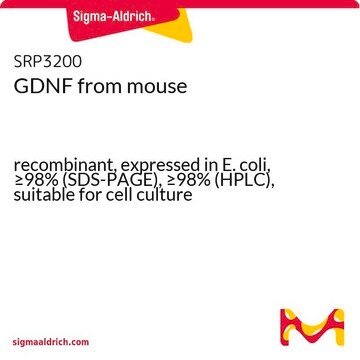SRP3146
Prokineticin-2 human
recombinant, expressed in E. coli, ≥98% (SDS-PAGE), ≥98% (HPLC), suitable for cell culture
Synonym(s):
PK2, PROK2, Protein Bv8 homolog
Sign Into View Organizational & Contract Pricing
All Photos(1)
About This Item
UNSPSC Code:
12352200
NACRES:
NA.32
Recommended Products
biological source
human
recombinant
expressed in E. coli
Assay
≥98% (HPLC)
≥98% (SDS-PAGE)
form
lyophilized
mol wt
8.8 kDa
packaging
pkg of 20 μg
technique(s)
cell culture | mammalian: suitable
impurities
<0.1 EU/μg endotoxin, tested
color
white
UniProt accession no.
shipped in
wet ice
storage temp.
−20°C
Gene Information
human ... PROK2(60675)
General description
Prokineticin-2 (PK2) is a cysteine-rich secreted protein that is expressed in the testis and in lower levels of the small intestine. PK2 regulates various biological functions including gastrointestinal motility, angiogenesis and circadiam rhythms. It is closely related to EG-VEGF (Prokineticin-1) and binds to two orphan B-protein-coupled receptors termed PK-R1 and PK-R2. Recombinant human Prokineticin-2 is an 8.8 kDa protein consisting of 81 amino acid residues and ten cysteine residues that potentially form five intra-molecular disulfide bonds.It also contains completely conserved N-terminal hexapeptide sequence that is involved in biological activity. PK2 is encoded by the gene mapped to human chromosome 3p13.
Biochem/physiol Actions
Prokineticin-2 (PK2) plays a vital role in regulation of various biological functions, such as gastrointestinal motility, angiogenesis and circadian rhythms. It is closely related to EG-VEGF (endocrine gland-derived vascular endothelial growth factor)/prokineticin-1 (PK1). PK1 and PK2 exert their function by interacting with two G protein-coupled receptors PKR1 and PKR2, respectively. PK2 is a candidate gene for the pathogenesis of mood disorders.
Sequence
AVITGACDKD SQCGGGMCCA VSIWVKSIRI CTPMGKLGDS CHPLTRKVPF FGRRMHHTCP CLPGLACLRT SFNRFICLAQ K
Physical form
Lyophilized with no additives.
Reconstitution
Centrifuge the vial prior to opening. Reconstitute in water to a concentration of 0.1-1.0 mg/ml. Do not vortex. This solution can be stored at 2-8°C for up to 1 week. For extended storage, it is recommended to further dilute in a buffer containing a carrier protein (example 0.1% BSA) and store in working aliquots at -20°C to -80°C.
Storage Class Code
11 - Combustible Solids
WGK
WGK 3
Flash Point(F)
Not applicable
Flash Point(C)
Not applicable
Certificates of Analysis (COA)
Search for Certificates of Analysis (COA) by entering the products Lot/Batch Number. Lot and Batch Numbers can be found on a product’s label following the words ‘Lot’ or ‘Batch’.
Already Own This Product?
Find documentation for the products that you have recently purchased in the Document Library.
Prokineticin 2 and circadian clock output.
Zhou Q Y and Cheng M Y
FEBS Journal, 272(22), 5703-5709 (2005)
Possible association of prokineticin 2 receptor gene (PROKR2) with mood disorders in the Japanese population.
Kishi T, et al.
Neuromolecular Medicine, 11(2), 114-122 (2009)
The prokineticins: a novel pair of regulatory peptides.
Zhou Q Y.
Molecular Interventions, 6(6), 330-330 (2006)
Takatoshi Soga et al.
Biochimica et biophysica acta, 1579(2-3), 173-179 (2002-11-13)
Recent studies have identified two novel biofunctional proteins, termed prokineticin 1/EG-VEGF and prokineticin 2, which were mammalian homologues of mamba MIT1 and frog Bv8. Prokineticins have been demonstrated to exert their physiological functions through G-protein coupled receptors (GPCRs). In this
Clayton M Bullock et al.
Molecular pharmacology, 65(3), 582-588 (2004-02-24)
Prokineticins are cysteine-rich secreted proteins that regulate diverse biological processes, including gastrointestinal motility, angiogenesis, and circadian rhythms. Two closely related G protein-coupled receptors that mediate signal transduction of prokineticins have recently been cloned. The structural elements required for prokineticins' bioactivities
Our team of scientists has experience in all areas of research including Life Science, Material Science, Chemical Synthesis, Chromatography, Analytical and many others.
Contact Technical Service







